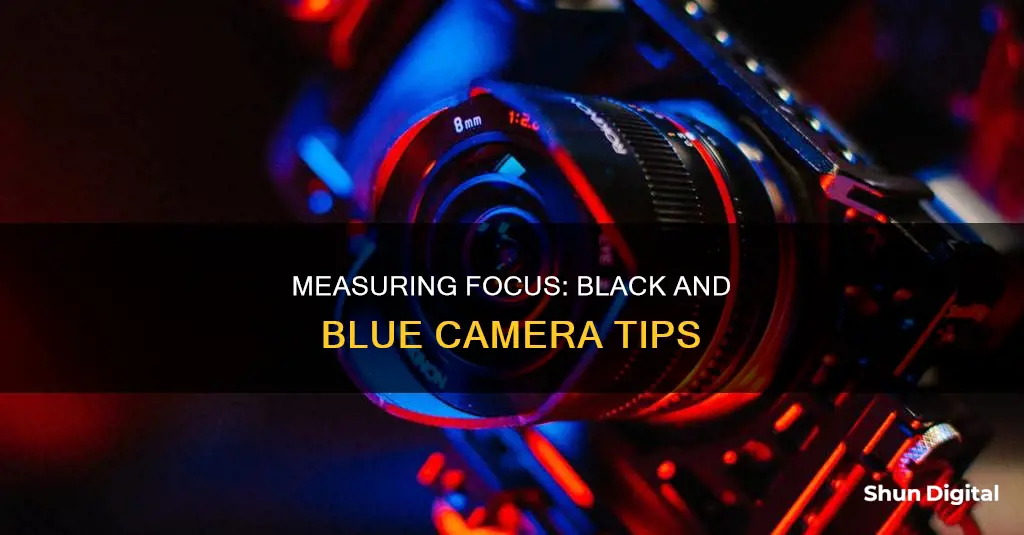
Measuring focus is a crucial aspect of filmmaking, ensuring that the footage is sharp and not blurry or out of focus. The 1st Assistant Camera (AC), also known as the focus puller, is responsible for judging the distance between the camera and the subject and manipulating the lens to maintain focus. While modern cameras have autofocus features, understanding how to measure focus manually is essential for achieving the desired results. This involves using tools like soft tape, hard tape, and laser tape measures to determine the distance between the camera and the subject. Additionally, factors such as the flange focal distance, back focus, and depth of focus play a role in achieving accurate focus. By combining these techniques and understanding the underlying concepts, camera assistants can ensure that their shots are crisp and clear.
| Characteristics | Values |
|---|---|
| Why measure for focus? | Focus is set and determined through distance. |
| The most dependable way to keep a subject in focus. | |
| When to measure for focus? | When using ENG lenses, measure from the front of the lens. |
| Measure to each subject in the scene. | |
| Measure to a few reference objects. | |
| How to measure for focus? | Start at the film/sensor plane. |
| Measure to each subject in the scene. | |
| Measure to a few reference objects. | |
| Transfer your marks. | |
| Tools to measure focus | Soft tape |
| Hard tape | |
| Laser tape |
What You'll Learn

Start at the Film/Sensor Plane
To measure focus, you need to start at the film/sensor plane of a camera. This is the surface of the camera where the lens creates a focused image. The film/sensor plane is located behind the lens and its exact location is designated by a "Phi" or "Φ" mark on the body of the camera. This mark is also sometimes referred to as the film plane indicator, represented by a circle with a line through it. This symbol indicates that the camera has been cut in half, with the line cutting right through the front of the camera's sensor.
The film/sensor plane is the starting point for measuring the focal distance of a lens. The actual focusing distances of the lens are measured from the surface of the camera's sensor or film, not from the front or back of the lens. By starting the measurement from the film/sensor plane, you can ensure that the image is focused on the exact location where the film or digital sensor is positioned during exposure.
Different camera manufacturers may have variations in the distance of the film plane from the lens. Therefore, it is crucial to carefully choose the right lens to ensure that the image is focused precisely where it needs to be. This is particularly important when working with film cameras, as the film stock may be bent slightly to compensate for Petzval field curvature, affecting the area of critical focus and sharpness.
Measuring from the film/sensor plane is applicable for most lenses. However, when using ENG (Electronic News Gathering) lenses, identified by a green stripe around the barrel, you would measure from the front of the lens instead.
ZS50: In-Camera Charging Supported?
You may want to see also

Measure to Each Subject in the Scene
The next point of measurement is the subject you are focusing on. If there are multiple subjects in a scene, you will have to take multiple measurements. Most of the time, the subject is a character, but sometimes it is not. It could be a door handle, a telephone, or even a skeleton on a road. Whatever the subject is, you measure the part of it that you want to be in focus. This is a crucial concept. You can't simply measure the distance to the subject itself. In some scenarios, your depth of field could be very shallow, meaning only parts of a subject will be in focus. That's why you measure the most important part of a subject to be in focus. For humans, this is the eyes. It would look strange if the tip of someone's nose was in focus and their eyes weren't. Or if their ears were in focus but not their face.
Camera Tickets: Legal in Tennessee?
You may want to see also

Measure to Reference Objects
Reference marks are crucial when the distance between the camera and the subject is inconsistent. For instance, if you're filming a choreographed fight scene, the actors might be 6 feet apart at one moment and 9 feet apart the next. In such cases, you can't rely solely on measuring the distance to the subjects.
Here's where reference objects come in. You can find points in the room that you can measure to and then, during the scene, adjust your focus based on the actors' positions relative to these reference points. Look for objects that are visible from beside the camera and clearly indicate the actors' relation to them.
It's best to have reference marks in front of, beside, and behind the points of action to prepare for any scenario, including the unexpected. For instance, if there's a couch the actors are fighting near, or a table, or a bookshelf, these can all serve as reference points.
Once you've identified your reference objects, you can transfer these marks to your lens or follow focus, or create a "mental map" by making mental notes of these reference points. This way, you can quickly adjust your focus during the scene, ensuring that your subjects remain sharp and clear.
Remember, measuring distances and getting those marks is the foundation for successfully pulling focus. While you can also judge focus using monitors and viewfinders, measuring by distance is more dependable and will ensure your footage is consistently in focus.
Focusing Phantom 4 Camera: Tips for Clearer Shots
You may want to see also

Transfer Your Marks
Transferring your marks is the final step in measuring for focus. The marks you make will depend on the number of subjects in the scene. If there are multiple subjects, you will need to take multiple measurements.
The most important marks, such as character landing marks, should be transferred onto the lens or follow focus. Less important marks, such as reference points, can be noted mentally.
You can make marks directly on the lens using a grease pencil or a thin strip of tape. Markings on the lens offer the best accuracy and consistency, but can be hard to see on smaller lenses.
Alternatively, you can mark on the follow focus, which offers better visibility and the ability to use more colours. However, this method can be less accurate and requires more time to glance over at the marks.
When marking actors, it is important to use different colours of tape for each actor to avoid confusion. The colour red is typically used for the lead actor, while blue is used for the second lead or most prevalent supporting actor. Other colours can be assigned based on preference.
Activating Camera Mode in Kingdom Hearts 3 on Xbox
You may want to see also

Understand Flange Focal Distance, Backfocus and Depth of Focus
Flange Focal Distance (FFD) is the distance from the camera's mounting flange to the film or sensor plane. It is also known as the flange-to-film distance, flange focal depth, flange back distance (FBD), flange focal length (FFL), back focus or register. The distance is usually expressed in millimetres.
The flange focal distance is a key measurement defining a particular lens mount standard. It is the determining factor in a camera's thickness. The distance varies between cameras and lens mounts, which explains the depth or thickness of lens mount adapters. For example, a Canon EF-mount has a flange focal distance of 44mm, while a Sony E-mount has a focal distance of 18mm. This means that a Canon EF to Sony E lens adapter needs to be 26mm thick to allow the lens to mount at the proper distance from the film or sensor plane, enabling the full range of focus from infinity to the minimum focus distance.
The flange focal distance is different from the back focal distance (BFD), which is the clearance between the rear lens surface and the film. Lenses can be adapted from one mount to another, but the flange focal distance determines whether infinity focus can be achieved with a simple non-optical adapter. A camera body with a shorter flange focal distance can typically accept a larger number of lenses with a longer flange focal distance by using a simple adapter.
In summary, the flange focal distance is a critical factor in lens and camera design, affecting the thickness of the camera and the compatibility of lenses through the use of adapters.
Power-Saving Mode: Friend or Foe to Your Camera?
You may want to see also
Frequently asked questions
To measure focus, you need to measure the distance between the camera and the subject. This is because focus is set and determined through distance.
You can use a soft tape measure, a hard tape measure, or a laser measuring device.
Attach the soft tape measure to a hook on the camera at the film plane and walk out with the spool until you reach the desired distance.
Stand by the camera and place the hard tape measure near the actor's eye.
Laser measuring devices are best for measuring long distances. Be careful not to shine the laser into an actor's eyes.
Measuring focus is a crucial skill for camera assistants, also known as focus pullers. Focus pullers are tasked with judging the distance between the camera and a subject and physically manipulating the lens to keep the subject in focus.







